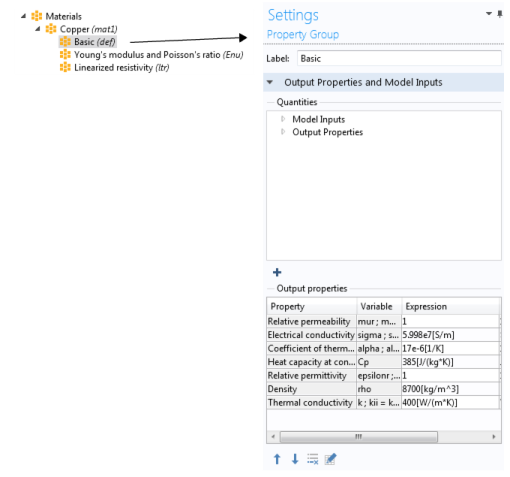The Settings window for
Property Group is where output properties and the model inputs are added, local properties are defined, and expressions for material properties are entered in a specific property group such as
Basic. The property groups are subnodes to a material node. The
Settings window for
Property Group is displayed when you click the property group node (for example,
Basic) under the material node (typically with the material’s name—
Aluminum, for example) in the
Model Builder.
The predefined material properties in the property group appear in the Output properties table. Under
Quantities you can add additional material properties to the
Output properties list or add model inputs to the
Model inputs list.
The model inputs are physical quantities, such as temperature, that are used as inputs in the expressions that define the output properties (for example, to describe a temperature-dependent physical quantity). For example, adding Temperature as a model input with the variable name
T makes it possible to use an expression for the heat capacity at constant pressure
Cp, such as
300[J/(kg*K)]*T[1/K], which works regardless of the name of the actual dependent variable for temperature in the model that uses the temperature-dependent material. Without the model input, the expression above only works with a temperature variable called
T.
If required, edit the expressions in the Output properties list’s
Expression column. Edit directly in the table or by clicking the
Edit button (

), which opens a dialog box for easier specification of orthotropic and anisotropic material properties (tensors). Select
Isotropic,
Diagonal,
Symmetric, or
Anisotropic when entering the data in the material property’s dialog box. In the
Expression column, use a syntax with curly braces such as
{k11, k21, k31, k12, k22, k32, k13, k23, k33} to enter anisotropic material properties for a 3-by-3 tensor
kij in the order
k11,
k21,
k31,
k12,
k22,
k32,
k13,
k23, and
k33. 1, 2, and 3 represent the first, second, and third direction in the active coordinate system. In many cases (for example, when entering the elasticity matrix for structural mechanics), the matrix must for physical reasons be symmetric. The upper diagonal part of the matrix you enter will then be mirrored when forming the actual constitutive matrix, and the lower diagonal part is ignored.
Use the Move up (

),
Move down (

), and
Delete (

) buttons to organize the tables as needed.
Here you can enter a user-defined Property and its corresponding
Expression and organize the table as needed. These local properties are useful for parameterizing functions that describe material properties if they contain inputs other than those that are model inputs (such as temperature and pressure). For example, a local property can be a reference value at a certain temperature. Use the
Move up (

),
Move down (

), and
Delete (

) buttons to organize the tables as needed.
Material property groups are automatically added to the material node in the Model Builder. You can also add additional predefined property groups or create a
User-Defined Property Group (on the
Materials toolbar, click
User-defined Property Group (

) or right-click the
Material node). The available properties are collected in property groups according to the physical context.
Each property group has a Settings window for
Property Group. When a
Model Builder node is clicked (for example,
Basic), the
Settings window for
Property Group displays specific information about that property group. The physical properties for all property groups are summarized in a
Material Contents table on the
Settings window for
Material.
